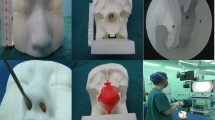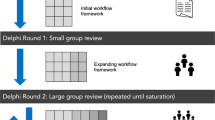Abstract
Background
Transsphenoidal endoscopic surgery has gained popularity in the last 2 decades and is becoming a standard technique for resection of pituitary adenomas. In contrast to their ENT colleagues, neurosurgical residents have practically no endoscopic experience when they reach the training stage for transsphenoidal procedures. We have developed an affordable method for repetitive training in endoscopic (and microscopic) work in a narrow channel, allowing training of the basic movements needed for resection of pituitary adenoma.
Methods
In collaboration with colleagues in the ENT Department, Cantonal Hospital St. Gall, and the Technical University of Zurich, a three-dimensional model of the nasal cavity was developed and patented. The Egghead model consists of a 3D synthetic reconstruction of the head nasal cavity and sphenoid sinus. A boiled egg represents the sella. For validation, 17 neurosurgical residents from the Department of Neurosurgery, University Hospital of Basel, and Department of Neurosurgery, Cantonal Hospital of St. Gall, St. Gall, Switzerland, and two experts performed a standardized procedure mimicking a transsphenoidal pituitary procedure by dissecting a corridor to the egg yolk and resecting it, respecting the surrounding egg white. This procedure was performed under both microscopic and video-endoscopic visualization. A score for the precision and speed of the surgical performance was developed and used.
Results
The model allows repetitive training of the resection of the egg yolk under sparing of the egg white after careful opening of the shell. The validation data showed a steeper learning curve using the endoscopic technique than performing the same task using the microscope. After three repetitions, the quality of resection was better with the endoscopic technique.
Conclusions
Our model, the Egghead, is affordable, offers tactile feedback and allows infinite repetitions in basic training for pituitary surgery. It can be used for training of advanced neurosurgical residents, who thus far have very few possibilities of acquiring endoscopic experience.



Similar content being viewed by others
References
Bakker NH, Fokkens WJ, Grimbergen CA (2005) Investigation of training needs for functional endoscopic sinus surgery (FESS). Rhinology 43(2):104–108
Burchiel K (2013) Commentary: simulation training in neurological surgery. Neurosurgery 73(4):6–7
Choudhury N, Gélinas-Phaneuf N, Delorme S, Del Maestro R (2013) Fundamentals of neurosurgery: virtual reality tasks for training and evaluation of technical skills. World Neurosurg 80(5):e9–e19
Csókay A, Papp A, Imreh D, Czabajszky M, Valálik I, Antalfi B (2013) Modelling pathology from autolog fresh cadaver organs as a novel concept in neurosurgical training. Acta Neurochir (Wien) 155(10):1993–1995
Dagi TF (2013) Commentary: the roles and future of simulation in neurosurgery. Neurosurgery 73(Suppl 1 (4)):S4–S5
Dahmen U, Sänger C, Wurst C, Arlt J, Wei W, Dondorf F, Richter B, Settmacher U, Dirsch O (2013) Video-based self-control in surgical teaching. A new tool in a new concept. Chirurg 84(10):851–858
Francis HW, Masood H, Laeeq K, Bhatti NI (2010) Defining milestones toward competency in mastoidectomy using a skills assessment paradigm. Laryngoscope 120(7):1417–1421
Gasco J, Holbrook TJ, Patel A et al (2013) Neurosurgery simulation in residency training: feasibility, cost, and educational benefit. Neurosurgery 73(Suppl 1(4)):S39–S45
Gélinas-Phaneuf N, Del Maestro RF (2013) Surgical expertise in neurosurgery: integrating theory into practice. Neurosurgery 73(Suppl 1(4)):S30–S38
Harrop J (2013) Introduction to neurosurgical simulation. Neurosurgery 73(Suppl 1(4)):S8
Harrop J, Lobel DA, Bendok B, Sharan A, Rezai AR (2013) Developing a neurosurgical simulation-based educational curriculum: an overview. Neurosurgery 73(Suppl 1(4)):S25–S29
Jagannathan J, Laws E, Jane J (2012) Advantage of the endoscope and transitioning from the microscope to the endoscope for endonasal approaches. In: Kassam AB, Gardner PA (eds) Endosc. Approaches to skull base. Karger, Basel, pp pp 7–pp 20
Limbrick DD, Dacey RG (2013) Simulation in neurosurgery: possibilities and practicalities: foreword. Neurosurgery 73(Suppl 1(4)):S1–S3
Lynch J, Aughwane P, Hammond TM (2010) Video games and surgical ability: a literature review. J Surg Educ 67:184–189
Okuda T, Kataoka K, Kato A (2010) Training in endoscopic endonasal transsphenoidal surgery using a skull model and eggs. Acta Neurochir (Wien) 152(10):1801–1804
Okuda T, Yamashita J, Fujita M, Yoshioka H, Tasaki T, Kato A (2014) The chicken egg and skull model of endoscopic endonasal transsphenoidal surgery improves trainee drilling skills. Acta Neurochir (Wien) 156(7):1403–1407
Ou Y, McGlone ER, Camm CF, Khan OA (2013) Does playing video games improve laparoscopic skills? Int J Surg 11(5):365–369
Reznick R, Regehr G, MacRae H, Martin J, McCulloch W (1997) Testing technical skill via an innovative “bench station” examination. Am J Surg 173(3):226–230
Rosseau G, Bailes J, Del Maestro R et al (2013) The development of a virtual simulator for training neurosurgeons to perform and perfect endoscopic endonasal transsphenoidal surgery. Neurosurgery 73(Suppl 1):S85–S93
Rosser JC, Lynch PJ, Cuddihy L, Gentile DA, Klonsky J, Merrell R (2007) The impact of video games on training surgeons in the 21st century. Arch Surg 142(2):181–186, discusssion 186
Schlickum MK, Hedman L, Enochsson L, Kjellin A, Felländer-Tsai L (2009) Systematic video game training in surgical novices improves performance in virtual reality endoscopic surgical simulators: a prospective randomized study. World J Surg 33(11):2360–2367
Tasman A, Wallner F, Kolling G, Stammberger H (1998) Is monocular perception of depth through the rigid endoscope a disadvantage compared to binocular vision through the operating microscope in paranasal sinus. Am J Rhinol 12:87–91
Voelcker-Rehage C (2008) Motor-skill learning in older adults—a review of studies on age-related differences. Eur Rev Aging Phys Act 5(1):5–16
Acknowledgments
This project was funded by the Clinical Trials Unit Commission of the Canton of St. Gall, Switzerland. The authors thank Karl Storz® for providing the endoscopic setup. The authors also thank Prof. Rachel Rosenthal, Department of Surgery, Basel University, for input on training models in surgery and Karin Inauen, BSc, for assistance during the experiments.
Conflict of interest
The authors declare that they have no conflict of interest. The services of Inspire AG (Schindel and Schmidt) for cooperation with development and production were reimbursed at regular rates.
Author information
Authors and Affiliations
Corresponding author
Additional information
Comment
This is an interesting article describing an affordable training model for endoscopic transsphenoidal surgery—this could easily be incorporated into any neurosurgical training program. It seems a very good introduction to endoscopic neurosurgery in general. The methodology of the study is sound. It will be interesting in the future to gain more insight into the value of the type of practical technical skill training in neurosurgery and whether such training tools can be used to judge the aptitude of the individual trainee for certain types of procedures. It is indeed interesting that some of the trainees outperformed the experts, even though they had no previous hands-on experience with the surgical technique. It might well be that this is because the generation of upcoming neurosurgeons has spent more time playing video games, as suggested by the authors. Therefore, we need to consider the indications of such results. Should there be a change of guard where the older "non-video game" generation steps aside and lets the best man or woman do the job—or should we spend a bit more time playing video games? As funny as this might seem, it is always worth considering how we can assure that operations are always performed by the best possible technician in the unit.
Jannick Brennum
Copenhagen,Denmark
Rights and permissions
About this article
Cite this article
Engel, D.C., Ferrari, A., Tasman, AJ. et al. A basic model for training of microscopic and endoscopic transsphenoidal pituitary surgery: the Egghead. Acta Neurochir 157, 1771–1777 (2015). https://doi.org/10.1007/s00701-015-2544-z
Received:
Accepted:
Published:
Issue Date:
DOI: https://doi.org/10.1007/s00701-015-2544-z




